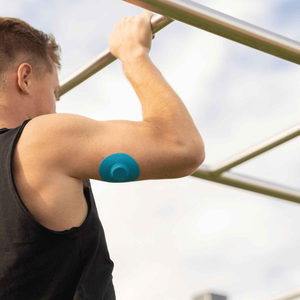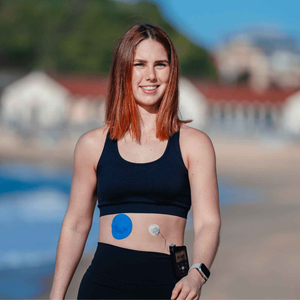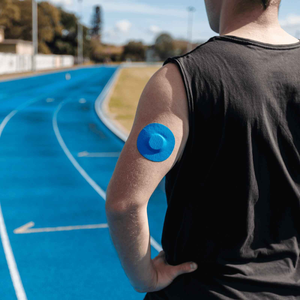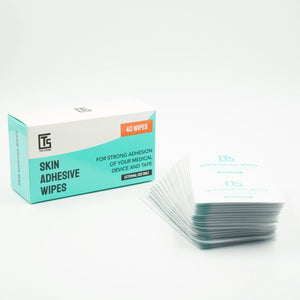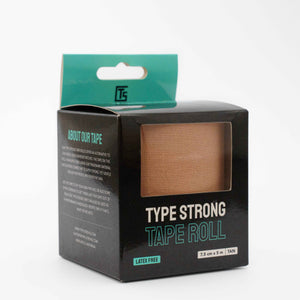Exploring the world of continuous glucose monitoring became more interesting with FreeStyle Libre versions 1, 2, and the newest 3. If you're managing diabetes and looking for the best fit, it's essential to understand the differences between these CGM systems. This article is your guide to the evolution of FreeStyle Libre, breaking down the features and improvements of each version. Whether you're thinking about an upgrade or trying it for the first time, we're here to guide you in making an informed decision. Let's dive into the comparisons between FreeStyle Libre 1, 2, and 3.
Before we continue, At Type Strong, we support individuals with diabetes by providing innovative products like our FreeStyle Libre adhesive patches. Choose the best CGM for your needs and enhance your experience with our high-quality adhesive patches today!
FreeStyle Libre Versions
Let's talk about the versions. There are three: Freestyle Libre 1 (the OG), Libre 2 (the upgrade), and Libre 3 (the latest).
Beginning with the basics, a small sensor is applied to the upper arm, providing continuous glucose monitoring, and a device displays the readings. This innovation eliminates frequent finger pricking, offering a comprehensive 24/7 glucose trend. This transformative system has notably enhanced the quality of life for those managing diabetes, positively impacting both daily monitoring and hemoglobin A1c (HbA1c) levels.
Now, turning our attention to the crucial differences between these versions despite their shared ease of application and user-friendly features. Notably, all Libre sensors last for a convenient two weeks after application, offering a consistent time frame. However, beyond these commonalities, each version introduces distinct characteristics. Let's explore these disparities to assist you in choosing the most suitable FreeStyle Libre based on your unique needs.
Differences of FreeStyle Libre 1,2 & 3
SIZE AND DESIGN
When we look at the new Freestyle Libre 3 sensor, we see that it’s much smaller and thinner than all previous generations of Libre. 60% smaller, to be exact. The sensor also boasts a more subtle matte finish. This increased discretion extends to the people around you, including strangers, who are less likely to notice it.
The Libre 3 also comes in a much smaller box. So it’s easier to store. When you get a shipment, the box will not be so big.
DATA TRANSFER
The next difference is how data is transferred from your sensor to the reader. The sensors use different technology to do that. With Libre 1 and Libre 2, you must scan the sensor with your receiver or phone to see your current glucose reading. The system uses NFC technology, just like paying with a credit card.
With Libre 3, the glucose information is automatically updated on your receiving device as long as the sensor is within a 10.05 metre distance.
This might not seem like a big difference, but in real life, it is. Each of these solutions has its pros and cons.
SCANNING
Scanning with Freestyle Libre 1 and Freestyle Libre 2 is only sometimes 100% reliable. Sometimes, you have to scan multiple times to get the actual reading. It can get annoying if you scan every time you want to see your current glucose on Libre 1 and Libre 2.
With Libre 3, you don’t need to bother yourself with scanning. You get a constant flow of real-time data to your receiving device. You only need to scan with Freestyle Libre 3 during the initial setup. After that, everything happens automatically.
TRANSFER AND SAVE DATA
Losing data with Libre 1 and Libre 2 is much easier because the sensor only holds the data for 8 hours. It would help to scan the sensor at least every 8 hours to transfer the data and save it on your receiving device. With Libre 3, you don’t have to worry about that. The data is transferred and saved automatically.
SENSOR HEIGHT
The next difference is how well these sensors stay on. Everyone who’s ever used a CGM has probably ripped it out of the door frame or when taking off a t-shirt. These kinds of accidents happen a lot less with Libre 3. Because it has such a low profile when it comes to sensor height. Every millimetre matters because that millimetre can save the sensor from the bra strap or sleeve of your shirt.
Libre 3 also feels much more comfortable when you wear a tighter shirt or lay on it in your sleep. Libre 3 doesn’t bother you as much on your body as Libre 1 or Libre 2. On the other hand, Libre 3 has a much smaller contact area for the adhesive to stick to your skin. And it can peel off a lot easier. Especially when you get caught on something.
You can use an over-patch with a Freestyle Libre sensor. Our adhesive patches are super flexible, which makes them easy to put on. And they’re also durable, keeping your sensor in place for the entire sensor duration without any issues.
APPLICATOR
Speaking of sensor applications. There is another slight difference between Libre 3 and all other Libre sensors. The older models come in two separate pieces. One is the applicator and the sensor itself. You need to line them up and press down firmly on the applicator. Ideally, on a hard, flat surface, which will load the applicator with the actual glucose sensor. You lift the applicator, and only then, place it over the side and push down firmly to apply it.
The Freestyle Libre 3 applicator is already loaded in the package. Once you unscrew the cap, you can apply it immediately, making the whole process a bit faster and easier.
ALARMS
This might be important for those who like to have close control over their blood sugars. And this is much easier to do with Libre 2 and Libre 3 because they offer alarms. Those optional alarms can alert you on your phone or your receiver anytime your blood sugar crosses the set threshold.
If you appreciate having alarms, both Libre 2 and 3 are excellent choices as they alert you when your blood sugar levels are too high or too low, giving you ample time to respond.
The use of alarms with Libre 2 has shown notable improvements in timing range and HbA1c compared to using Libre 1.
However, it's essential to consider the potential challenges when dealing with frequent alarms, especially if you have diabetes. Multiple alarms throughout the day and night can lead to alarm fatigue, burnout, or even more concerning, prompting panic decisions under the pressure of constant alerts. It's crucial to strike a balance that suits your needs and preferences to manage your diabetes effectively without unnecessary stress.
GLUCOSE READING
Another difference between Libre 2 and Libre 3 is when you get the alarm on Libre 2. The system only tells you that your blood sugar is high or your blood sugar is low. But it doesn’t tell how high or low it is. You need to scan to see your actual glucose number and your glucose Trend arrow.
Libre 3 has this information instantly available, which is great because when your blood sugar is too low or too high, you just want the information right away.
READER/DEVICE
The next difference is how you view your glucose readings. This one is quite simple for all 3 versions. You can use an app or a dedicated reader on your mobile phone. Regardless of which Freestyle Libre sensor version you use.
Some people prefer an app on their phone because they don't like carrying another device around. But also, some people choose the reader because they want to have their blood data on a dedicated device. They don't want to carry their phone everywhere with them.
Another reason is that the reader doesn't drain the phone battery, and the battery on the reader is rechargeable. And it lasts a lot longer than a mobile phone battery.
The reader for Libre 1 is black. The reader for Libre 2 is blue. And the reader for Libre 3 is silver. Unfortunately, all of them only work with the same sensor version. You won't be able to use the Freestyle Libre 3 sensor with the Freestyle Libre 2 reader.
Each sensor version has a dedicated app, which you must install on your mobile phone. You can download these apps on IOS and Android devices in most countries. The apps are almost identical.
The most notable difference is that the freestyle Libre 3 app can be switched to a dark mode. The other apps can't do that. It's not a game changer, but it is a nice feature if you don't want to wake up your partner or baby during the night with this light.
On the other hand, the other Freestyle Libre 2 app saves your blood glucose information in the log every time you scan. The Libre 3 app doesn't do that, but this is not a dealbreaker.
FEATURES
Each new Freestyle Libre version is getting more and more security features. This is good because your data is more secure. On the other hand, it’s not so good because it makes it harder and harder to use the data from the sensor with unauthorised apps or solutions.
ACCURACY
Another difference between sensors is how accurate they are. A common way to measure the accuracy of CGM is to use mean absolute relative difference or MARD. The lower MARD, the more accurate. Like when you play golf, the lower the score, the better the player.
Older models, such as Libre 1 or Libre 14 days, had a MARD of 9.3%. However, with Libre 2, the likelihood of breakage is reduced.
Freestyle Libre 3 has a MARD of 7.9%. This is the lowest of any CGM currently on the market. So Libre 3 is theoretically a bit more accurate.
READING TIME
Freestyle Libre 3 readings update every minute. While the other models update only every 5 minutes. So, with Freestyle Libre 3, you can get more timely information about your glucose which might make it seem like the sensor is more accurate.
But don't get too caught up on the accuracy when deciding between Libre 3 and Libre 2 or any other Libre versions.
All modern CGMs are accurate enough. So when deciding, the focus is not on plus-minus one percent in accuracy. The consideration revolves around whether they have the features the individual likes or needs.
AVAILABILITY
Another difference you will encounter is that some Freestyle Libre sensors or reader versions might not be available in your location. Freestyle Libre 1 sensors are available in almost all first-world countries. Libre 2 and Libre 3 are available in most countries. But keep in mind that the Libre 3 technology is quite new.
INSURANCE COVERAGE
Next is related to insurance coverage. Here are the most important points since Freestyle Libre 3 is new. It is less widely approved than Libre 1 or Libre 2.
Some insurances like Medicare don’t cover Freestyle Libre 3 yet, but they do cover Freestyle Libre 2 for all insulin-dependent diabetics. But outside of insurance coverage, the price should not be a decision factor for you because the Libre sensors, regardless of their version, typically cost the same.
Maybe, the reason why you’re reading this is to find out which Freestyle Libre sensor would be the best choice to choose.
Features of FreeStyle Libre 1,2 & 3
Freestyle Libre 1:
- It keeps track of your glucose all the time.
- You only need to scan every 8 hours.
- No annoying alarms to deal with.
- Easy to find – available almost everywhere.
Freestyle Libre 2:
- It's the newer version, but it looks just like Libre 1.
- Still requires scanning but comes with alarms.
Freestyle Libre 3:
- The latest model on the block.
- It's way smaller, about 60% less.
- It packs alarms.
- Cool feature: Can send glucose readings non-stop to your reader or phone.
- Bonus: Insurance has got it covered!
Wrapping Up
This might not seem like a big difference, but in real life, it is. Each of these FreeStyle Libre sensors has its pros and cons.
Consider factors like size, data transfer, scanning reliability, data saving, battery life, sensor height, applicator design, alarms, glucose reading details, device compatibility, features, accuracy, reading time, availability, and insurance coverage. Each version has its strengths and weaknesses.
Remember, the best choice depends on what matters most to you.
Consult with your healthcare professional and check local availability and insurance coverage to make an informed decision. Whichever you choose, welcome to the world of easier glucose monitoring – it's a game-changer for managing diabetes.
Enhance your CGM experience with Type Strong's high-quality adhesive patches. Whether you're using a Freestyle Libre 1,2 or 3, our patches provide the security and comfort you need.
Explore our full range of CGM patches today and make the most of your continuous glucose monitoring experience.
|
Disclaimer: The information presented on this blog is provided for general informational purposes only. It is not intended as a substitute for professional medical advice, diagnosis, or treatment. Reliance on any information provided by this blog is at your own risk, and we strongly recommend consulting with a qualified healthcare professional for individualised advice regarding your specific situation.
In addition, this blog may contain links to external sites or feature content from third parties. Please be aware that we do not undertake investigations or monitoring of these external links for accuracy, adequacy, validity, reliability, availability, or completeness. Consequently, we disclaim any liability or responsibility for the information contained therein. Users are encouraged to exercise their own judgement and discretion when accessing external content linked from this blog. |
